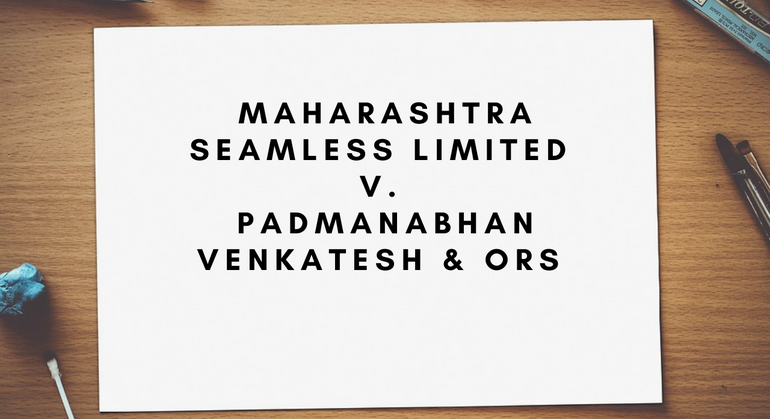

Maharashtra Seamless Limited v. Padmanabhan Venkatesh & Ors
Indian Bank the forerunner of the CIRP, filed an application under Section 7 of the Insolvency and Bankruptcy Code on 12th June 2017 against United Seamless Tubular Private Limited (Corporate Debtor). The said application was subsequently admitted by National Company Law Tribunal, Hyderabad. The total debt of Corporate Debtor was Rs. 1897 Crores of which Rs. 1652 Crores was in form of Term Loans from two entities of Deutsche Bank, and a working capital borrowing of Rs. 245 Crore from Indian Bank. In addition to that, the verified claims of the operational Creditor amounted to Rs.2.02 Crores.
The Resolution Professional received four Resolution Plansaltogether. Out of which the Resolution Plan submitted by Maharashtra Seamless Limited was approved by the majority of the CoC by 87.10% of the voting share and the Indian Bank or Financial Creditor having voting share 12.90% dissented with the Resolution plan of Maharashtra Seamless Limited.
The Adjudicating Authority, the National Company Law Tribunal, Hyderabad Bench (NCLT) by an order passed on 21st January 2019 sanctioning the resolution plan submitted by Maharashtra Seamless Limited in an application filed by the Resolution Professional. The aforesaid order passed by the Adjudicating authority was carried up in appeal before the National Company Law Appellate Tribunal (NCLAT), which were preferred by the Promoter of United Seamless and Indian Bank (Financial Creditor).
The arguments of Learned Counsel appearing on behalf of the appellant essentially hinged on the liquidation value. The Counsel contended that the liquidation value submitted by the Resolution Professional and accepted by the CoC for approval of the Resolution Plan was Rs. 597.54 Crores. Therefore, there could be no reason to release property valued at Rs.597.54 crores to Maharashtra Seamless Limited for Rs.477 crores. Moreover, strengthening their submission on this point the appellants made a reference to the other Resolution Applicant whose bid was for Rs.490 crores which were more than the amount offered by the Maharashtra Seamless Limited.
National Company Law Appellate Tribunal (NCLAT) responding to petitions found that Resolution Plan is against the statement and object of the Insolvency and Bankruptcy Code and thereby rejected the lender-approved resolution plan on the ground that the proposed upfront payment for the stressed asset of the Indo-Malaysian joint venture United Seamless Tubular, was significantly lower than the average liquidation value. Ergo, the court directed the winning bidder to modify the plan by paying an additional Rs. 120.54 Crores to make it at par with the average liquidation value of Rs.597.54 Crores. Accordingly, during the pendency of the present appeal under the watchful eye of the Apex Court, Maharashtra Seamless Limited documented an application before the Apex Court.
Issues
The issues in the present case were the following as under :
- Whether the scheme of the Code contemplates that the sum forming part of the resolution plan should match the liquidation value or not?
- Whether Section 12-A is the applicable route through which a successful Resolution Applicant can retreat?
Judgment
The Maharashtra Seamless Limited is the successful resolution applicant sought directions upon the corporate debtor as also the administrative and police authorities for effective implementation of the resolution plan. Maharashtra Seamless Limited was not being given access to the assets of the corporate debtor. Further, they have sought a refund of the sum deposited in terms of the resolution plan along with interest. In addition to which Maharashtra Seamless Limited has also applied for withdrawal of the resolution plan.
The contentions of the Maharashtra Seamless Limited being denied access to assets of corporate debtor and delay in implementation of the resolution plan. They had 477 crores deposited into an escrow account for the resolution of the corporate debtor. They were compelled to bear the interest for the amount of Rs.477 crores.
The Apex Court manifested that there is no provision in the Regulations or Code which provides that the bid of any Resolution Applicant has to match the liquidation value. It further articulated that the object behind prescribing such a valuation process is to assist the CoC to take decisions on a resolution plan properly. Once, a resolution plan is approved by the CoC, the statutory mandate on the Adjudicating Authority under Section 31(1) of the Code is just to test the Resolution Plan with reference to provisions of Section 30(2) of the Code.
The Supreme Court blazed that Maharashtra Seamless Limited cannot withdraw from the proceeding in the manner they have approached this Court. The exit route prescribed in Section 12-A is not applicable to a Resolution Applicant. The procedure envisaged in the said provision only applies to applicants invoking Sections 7, 9, and 10 of the code. The only route through which a resolution applicant can travel back after the admission of the resolution plan is the aforesaid provision. Section 12-A of the 2016 Code stipulates:
“12A. Withdrawal of application admitted under section 7, 9, or 10. – The Adjudicating Authority may allow the withdrawal of application admitted under section 7 or section 9 or section 10, on an application made by the applicant with the approval of ninety per cent. voting share of the committee of creditors, in such manner, as may be specified.”



